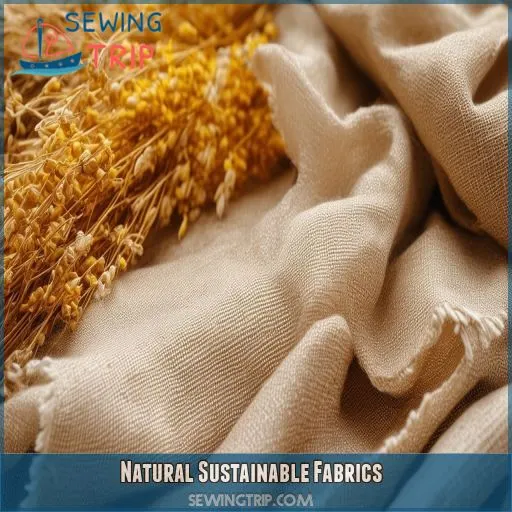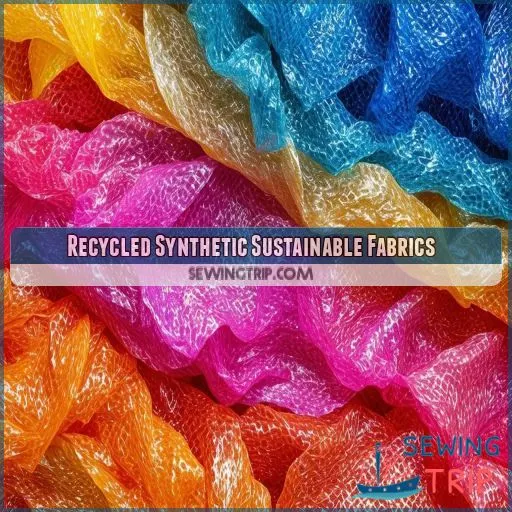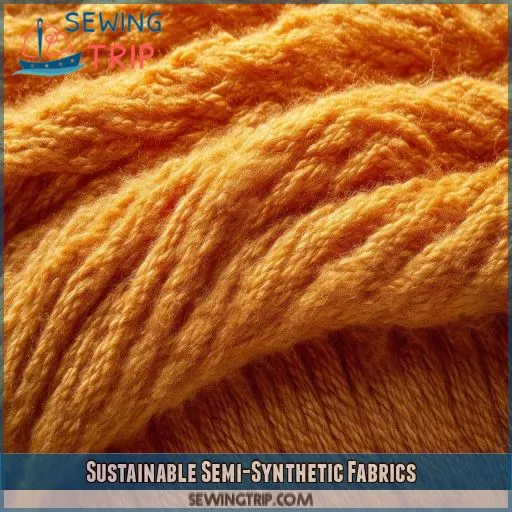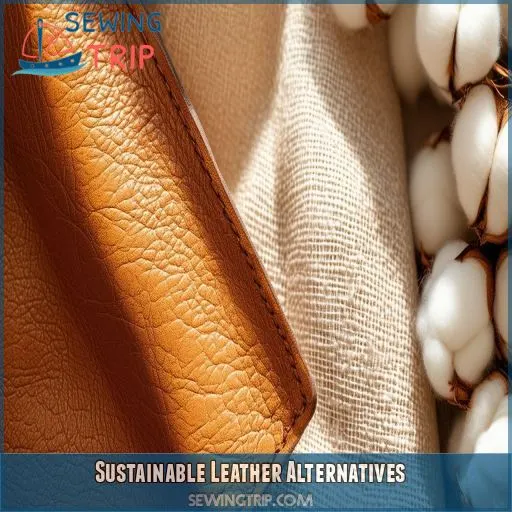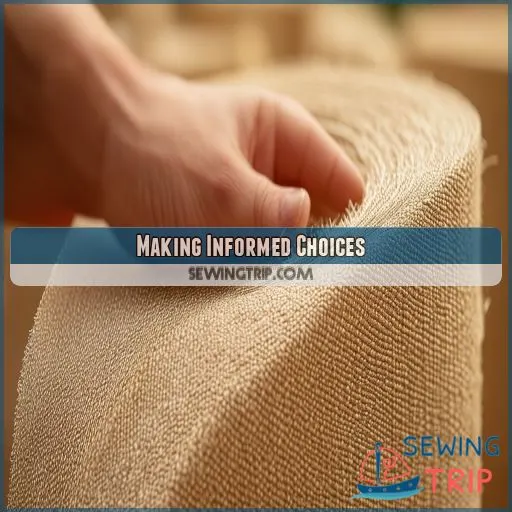This site is supported by our readers. We may earn a commission, at no cost to you, if you purchase through links.

From natural fibres like Organic cotton and hemp to innovative recycled materials, you’ve got a world of choices to explore.
Table Of Contents
Key Takeaways
- There’s a world of sustainable sewing fabric options to explore, from organic cotton and hemp to recycled materials like polyester and innovative vegan leathers.
- Choosing sustainable fabrics involves considering certifications, transparency in supply chains, responsible sourcing, and the environmental impact of production processes.
- Natural fabrics like organic cotton, hemp, linen, and bamboo are solid choices for eco-conscious sewists, offering breathability, durability, and comfort.
- Recycled synthetic fabrics, such as those made from plastic bottles or ocean waste, offer an innovative and eco-conscious alternative, reducing landfill waste and giving new life to discarded materials.
Sustainable Fabric Options
Sustainable sewing fabrics are a big deal, and it can be tough to know where to start. There are so many options to choose from, and it’s hard to know what’s best for you.
From organic cotton to recycled polyester, and hemp to Tencel, there’s a fabric for every project that won’t cost the earth.
Organic Cotton: Grown Without Harmful Pesticides
If you’re looking to make your sewing projects more eco-friendly, choosing the right fabric is a great place to start. Enter organic cotton, a natural, pesticide-free fabric that’s kind to both the environment and your skin. Here’s why it should be your go-to:
- No harmful pesticides: Organic cotton is grown without the use of harmful chemicals, reducing environmental impact and promoting eco-friendly cotton production.
- Soil health: This fabric prioritizes soil health and biodiversity, ensuring that the land used for cotton production remains healthy and productive for the long term.
- Soft and breathable: Its soft, breathable, and versatile nature makes it a comfortable and practical choice for various sewing projects, from clothing to home decor.
- Energy and water savings: With a much lower energy and water usage compared to conventional cotton, organic cotton is a more sustainable option that doesn’t compromise on quality.
Recycled Polyester: Made From Plastic Bottles
Let’s talk about recycled polyester, a fabric that gives plastic bottles a new lease of life. Each year, millions of plastic bottles end up in landfills or the ocean, contributing to waste and environmental pollution. But recycled polyester offers a clever solution by transforming these bottles into a versatile fabric.
This sustainable fabric is created by breaking down used plastic bottles into small flakes, which are then processed and spun into yarn. It’s like magic turning trash into treasure! Recycled polyester retains the durability and moisture-wicking properties of its virgin counterpart, making it ideal for activewear, outerwear, and accessories. So, you can stay stylish and comfortable while reducing your environmental impact.
Hemp: a Fast-Growing, Durable, and Naturally Pest-Resistant Fiber
Hemp is a sustainable superstar for eco-friendly fabrics. It’s a fast-growing, durable, and naturally pest-resistant fiber that checks all the right boxes for conscious crafters. With minimal water and pesticide requirements, hemp is an efficient and environmentally friendly choice.
Known for its strength and durability, hemp fabric is a workhorse that stands the test of time. It’s also naturally antibacterial, keeping your creations fresh and odor-free. And if you’re looking for comfort, hemp delivers with its breathable and moisture-wicking properties.
Whether you’re stitching up a sturdy garment, crafting accessories, or upholstering furniture, hemp is an excellent choice. It’s a versatile fabric that adds a touch of eco-consciousness to any project. So, go ahead and give hemp a try – it’s a sustainable step in the right direction!
Tencel: a Sustainable Alternative to Rayon
Tencel is a silky-smooth fabric with a sustainable twist.
It’s made from wood pulp, usually eucalyptus or bamboo, and produced using a closed-loop process that minimizes waste and environmental impact.
This eco-friendly fabric is breathable, with excellent moisture-wicking properties, making it perfect for dresses, blouses, and bedding.
Tencel offers a luxurious feel with a reduced environmental footprint compared to traditional rayon.
Bamboo: a Renewable Resource With Natural Antibacterial Properties
Bamboo is a superstar in the sustainable fabric world. It’s a renewable resource with a ton of growth potential. Those tall, graceful stalks can shoot up to 3 feet in just 24 hours, and they gobble up more CO2 than most trees.
But it’s not just about speed. Bamboo’s a fighter, too. It’s naturally antibacterial, so it keeps odors and icky stuff at bay. Plus, it’s a softie, with a silky-smooth texture that’s perfect for clothing and bedding.
However, the processing impacts its eco-friendliness:
- Bamboo Lyocell: Uses a closed-loop process, cutting down on nasty chemicals.
- Bamboo Viscose: Not so eco-friendly, with a side of toxic soup.
Natural Sustainable Fabrics
Natural fabrics are a key part of the sustainable sewing conversation. There’s a lot to think about when choosing the right materials for your projects, from their environmental impact to their durability and breathability.
In this section, we’ll explore some of the most popular natural sustainable fabrics and why they’re a great choice for eco-conscious crafters.
Organic Cotton: a Natural Choice
Organic cotton is a natural choice for eco-conscious sewists.
It’s grown without the harmful pesticides and synthetic fertilizers common in conventional cotton farming, reducing environmental impact.
With 62% less energy and 88% less water usage than regular cotton, it’s efficient and sustainable.
Soft, breathable, and versatile, it’s perfect for clothing and home decor.
Hemp: Strong, Durable, and Sustainable
Hemp fabric is a real winner when it comes to sustainability and durability. Here’s why it’s a top choice for eco-conscious sewists:
- Fast-growing and renewable: Hemp is a whiz at regenerating, so it can be harvested multiple times a year.
- Minimal water and pesticides: It sips, not gulps, water and keeps pesticides to a minimum.
- Strength and durability: Hemp fabric is built to last, so your creations will go the distance.
- Breathable and moisture-wicking: It keeps you cool and dry, making it perfect for activewear and upholstery.
Linen: a Classic With a Sustainable Edge
Linen is a classic fabric with a timeless appeal, but did you know it’s also a sustainable superstar? Yep, this fabric’s got more going for it than just good looks.
Linen is derived from the humble flax plant, and it’s one of the oldest textiles out there. But don’t let its age fool you – linen is a fresh take on sustainable fashion. It’s a natural choice for eco-conscious sewists like yourself because it requires less water and pesticides than other crops.
Linen’s natural texture and breathability make it a dream to work with. It’s soft, moisture-wicking, and biodegradable – perfect for lightweight, breathable garments like summer dresses and shirts. So you can stay cool and comfortable, all while looking fly and doing your bit for the planet.
Bamboo Linen: Harvested Without Killing the Plant
Bamboo linen is unique. Unlike other plants used for fabric, bamboo can be harvested without killing the plant. It’s a resilient plant that grows quickly and consumes more CO2 than most trees, making it an eco-friendly choice. This natural process leads to sustainable development and ethical production. The result is a breathable, comfortable fabric with natural antibacterial properties.
Lyocell: Made From Eucalyptus Wood Pulp
Lyocell, also known as Tencel, is a sustainable superstar in the fabric world.
Made from eucalyptus wood pulp, it’s a natural and eco-friendly alternative to traditional fabrics.
With a closed-loop production process, Lyocell minimizes waste and environmental impact.
It’s soft, silky, and breathable—perfect for comfy and stylish dresses, blouses, and bedding.
You can feel good about choosing Lyocell for your sewing projects, knowing it’s a sustainable option with a luxurious feel.
Recycled Synthetic Sustainable Fabrics
Recycled synthetic fabrics are an innovative and eco-conscious choice for sewists. In this section, we’ll explore four types of recycled synthetic fabrics that offer unique benefits and contribute to a more sustainable future.
ECONYL: Made From Recycled Ocean Plastic
Let’s talk about ECONYL, a fabric with a mission to save our oceans. Made from recycled ocean plastic, abandoned fishing nets, and waste fabric, ECONYL is a star in the sustainable fabric world. It’s here to rescue our oceans from plastic waste and give your sewing projects an eco-friendly boost.
ECONYL uses a closed-loop system, which means less water usage and fewer wasted resources. So, when you’re sewing, you’re not just creating something awesome, but also doing your part for the planet.
Recycled Polyester (rPET): Made From Recycled Plastic Bottles
Recycled polyester, or rPET, is an eco-friendly fabric made from an unexpected source: recycled plastic bottles. That’s right, those everyday plastic bottles can be transformed into versatile fabric for various clothing items.
Why choose rPET?
- Reduce landfill waste: By using rPET, you’re giving new life to plastic bottles that might otherwise end up in landfills, helping to reduce waste and conserve resources.
- Durability and moisture-wicking: rPET retains the durability and moisture-wicking properties of virgin polyester, making it ideal for activewear and outerwear.
- Sustainable activewear: rPET is a popular choice for sustainable activewear, so you can look good and feel even better knowing your clothing choices are helping the planet.
Deadstock Fabrics: Utilizes Off-Cuts and Manufacturing Scraps
Deadstock fabrics are an innovative way to reduce waste and create unique, sustainable garments. They utilize off-cuts, manufacturing scraps, and even unsold clothing to give new life to existing materials.
Deadstock fabrics offer an eco-friendly alternative to virgin fabrics. By using discarded resources, you keep valuable materials out of landfills, reducing the need for new fabric production. It’s a win for the environment and your creative sewing projects.
Sourcing deadstock fabric is a fun treasure hunt, offering a surprise element with limited runs and one-of-a-kind fabrics. Embrace your creativity and the unique challenge of working with these sustainable alternatives.
Modal: Made From Beech Trees
- Modal Source: Modal is made from beech tree pulp, a natural and renewable resource.
- Fabric Origin: Similar to viscose, but with a more sustainable production process that reduces waste and chemical usage.
- Environmental Impact: While modal requires fewer chemicals than traditional rayon/viscose, keep in mind that it’s not a completely chemical-free process.
Sustainable Semi-Synthetic Fabrics
Sustainable semi-synthetic fabrics offer an innovative twist to eco-friendly sewing. From bamboo lyocell to piñatex, these fabrics blend natural and synthetic sources, giving you the best of both worlds.
Bamboo Lyocell: Made in a Closed-Loop Process
If you’re looking for a sustainable semi-synthetic fabric, bamboo lyocell is a great option. It’s made through a closed-loop process, which means fewer toxic chemicals are used compared to regular bamboo viscose. This process also reduces water consumption and waste, making it a more sustainable choice.
| Bamboo Lyocell | Benefits |
|---|---|
| Closed-loop process | Reduces environmental impact by minimizing water use and waste |
| Fewer toxic chemicals | Less harmful to the environment and workers |
| Renewable resource | Bamboo is a fast-growing, sustainable plant |
| Natural antibacterial properties | Ideal for activewear and bedding |
ECOVERO: Uses Sustainable Wood and Pulp Sources
ECOVERO is a sustainable semi-synthetic fabric that’s kind to the planet and your wardrobe. Here’s why it’s a great choice for eco-conscious sewists like yourself:
- Sustainable Sourcing: ECOVERO uses wood and pulp sources that are responsibly and sustainably managed, ensuring the fabric’s production has a lower environmental impact.
- Reduced Carbon Footprint: This fabric is a leader in reducing carbon emissions. By choosing ECOVERO, you’re reducing carbon emissions by 50% compared to standard viscose or rayon. That’s a big deal in the fight against climate change!
- Water Conservation: ECOVERO helps reduce carbon emissions and also conserves water. With 50% less water used in its production compared to standard viscose, ECOVERO is a water-wise choice for your sewing projects.
Piñatex: Made From Pineapple Leaves
Pineapple leather, or Piñatex, is a sustainable semi-synthetic fabric made from pineapple leaves. This innovative textile is a byproduct of the food industry, utilizing pineapple leaves that would otherwise be discarded. With a unique production process, Piñatex offers a vegan alternative to traditional leather, combining durability and biodegradability.
The process of creating Piñatex involves using wood-based PLA resins to make the leaves more durable and guarantee the final product is biodegradable. This eco-friendly fabric is an exciting development in ethical fashion, providing a cruelty-free and sustainable option for those seeking an alternative to animal leather.
Piñatex shows how innovative and ethical changes in the fashion industry can create a brighter future. By embracing vegan fabrics like Piñatex, we take a step toward a more sustainable and conscious world.
Bananatex: Made From Organically-Grown Abacá Banana Plant Stalks
Next up, we’ve got Bananatex, a fabric made from organically-grown Abacá banana plant stalks. Yep, you read that right – banana stalks! Who knew those sturdy stalks could be transformed into a durable fabric?
This innovative fabric is a semi-synthetic superstar, offering a lower-impact alternative to traditional synthetic fabrics. With Bananatex, you’re looking at a more ethical development process and an eco-friendly supply chain. Plus, it’s certified Cradle to Cradle Gold, so you know it’s the real deal.
SCOBY Leather: Made From Kombucha SCOBY
If you’re after a vegan leather option, SCOBY leather is a unique, eco-friendly innovation. SCOBY stands for Symbiotic Culture of Bacteria and Yeast, and it’s made from—you guessed it—kombucha! This sustainable semi-synthetic fabric is biodegradable and compostable, and it doesn’t require any tanning chemicals. An ethical impact with a side of gut-healthy probiotics? Now that’s a fashion statement.
Sustainable Leather Alternatives
If you’re a leather lover but want to explore more eco-friendly options, there are plenty of innovative alternatives to traditional leather. From cork fabric to apple leather, these sustainable choices offer style and functionality without compromising the planet.
Cork Fabric: Harvested Sustainably From Cork Oak Trees
Let’s talk about cork fabric, a unique and sustainable leather alternative.
Cork fabric is harvested from cork oak trees, a valuable part of diverse ecosystems.
It’s a minimal-processing wonder, requiring way less factory fuss than other fabrics.
This eco-friendly fabric is a great choice for those seeking an animal-free alternative to leather, offering a durable and stylish option for sewing projects.
S.Cafe: Made From Used Coffee Grounds
S.Cafe is a unique fabric that’s taking the sustainable fashion world by storm. Made from used coffee grounds, it’s an innovative leather alternative that’s eco-friendly and functional.
You might be wondering, how can coffee grounds be turned into fabric? Well, it’s all about upcycling and eco-friendly development. Those leftover grounds from your morning brew are put to good use, creating a textile that’s sustainable and has some pretty impressive features.
S.Cafe fabric is designed to be quick-drying and provides natural UV protection, making it a great choice for outdoor gear and activewear. So, you’re reducing waste by upcycling coffee grounds, and you’re also getting a high-performance fabric that’s perfect for your next adventure.
With S.Cafe, you can feel good about your fabric choices, knowing that you’re supporting eco-friendly practices and rocking a one-of-a-kind material that’s as unique as your favorite coffee order.
Brewed Protein: Made From Fermented Plant-Derived Biomass
Brewed protein is a sustainable leather alternative that’s worth checking out. It’s made from fermented plant-derived biomass, which means it’s versatile and can be turned into different materials. This fabric is biodegradable and produces fewer greenhouse gases, so it’s better for the environment.
Apple Leather: Made From Apple Juice Industry Waste
Apple leather is a unique, eco-friendly vegan leather made from apple juice industry waste. It’s a sustainable option that’s also biodegradable, waterproof, and durable.
Here are three key benefits of choosing apple leather:
- Reducing waste: By using apple waste, this vegan leather alternative prevents apple juice industry byproducts from becoming landfill waste, giving them a new life as a durable material.
- Biodegradability: Unlike traditional leather, apple leather is biodegradable, meaning it won’t contribute to landfill waste at the end of its life.
- Practicality: Apple leather is a practical choice, offering both waterproof protection and durability, making it suitable for a range of applications.
Woocoa: Made From Hemp, Coconut Fibers, and Mushroom Enzymes
If you’re looking for an innovative, sustainable leather alternative, Woocoa is a fantastic option. It’s crafted from an unusual trio of materials: hemp, coconut fibers, and mushroom enzymes. This combination may sound like a strange recipe, but it creates a durable and eco-friendly fabric.
| Materials | Benefits |
|---|---|
| Hemp | Fast-growing, minimal water/pesticide needs |
| Coconut Fibers | Natural, renewable resource |
| Mushroom Enzymes | Sustainable alternative to tanning chemicals |
With Woocoa, you can create stylish and sustainable garments, accessories, or even upholstery. It’s a unique and exciting development in eco-friendly fabrics, offering a new way to bring your sewing projects to life.
Making Informed Choices
So many fabrics, so little time! But how do you know which ones are truly sustainable? It’s time to get clued up and make informed choices.
Let’s dig into the nitty-gritty of what makes a fabric sustainable, explore the most eco-friendly options, and find out how to spot greenwashing a mile off.
How Do You Know if Fabric is Sustainable?
Making informed choices about sustainable fabrics involves considering various factors. Here’s a simple guide to help you figure out eco-friendly fabrics:
- Certifications and Labels: Look for trusted certifications like GOTS (Global Organic Textile Standard) and OEKO-TEX, which guarantee that fabrics meet specific environmental and social criteria. These labels provide transparency and verify sustainable practices.
- Transparency and Traceability: Choose brands that are open and transparent about their supply chains and sourcing practices. Transparency builds trust and allows you to understand the impact of the fabric’s journey, from farm to shelf.
- Sourcing and Impact: Consider the origin and impact of the fabric. Prioritize fabrics with responsible sourcing practices, low water usage, minimal chemical use, and sustainable production methods.
- Fabric Options: Explore a variety of sustainable fabric options, including natural, recycled, and semi-synthetic choices. For example, organic cotton, hemp, Tencel, and recycled polyester are all eco-friendly alternatives to conventional fabrics.
- Beyond Fabric Choice: Remember, sustainability goes beyond the fabric itself. Consider the production processes, packaging, transportation, and end-of-life options. Ethical labor practices, fair wages, and safe working conditions are essential, along with minimizing packaging waste and prioritizing biodegradable or recyclable fabrics.
What is the Most Sustainable Choice in Fabrics?
It’s tricky to pinpoint the most sustainable fabric. It depends on what matters most to you. Are you keen on vegan fabrics only, or are you open to animal-based options, too? Do you want to avoid plastics, or do you prefer recycled synthetics?
Let’s say you’re all about vegan fabrics and want to skip the synthetics. In that case, natural fabrics like organic cotton, hemp, linen, and bamboo are solid choices. They tick the boxes for eco-friendliness and ethics.
But if you’re cool with animal-based fabrics, then wool and leather alternatives enter the scene. Think sheep wool, merino wool, or even SCOBY leather crafted from kombucha. These fabrics bring sustainability and style together.
What is the Most Sustainable Lining Fabric?
If you’re thinking about lining, you’ve got options.
For a natural choice, organic cotton is a versatile and breathable lining fabric.
If you’re after durability, hemp is a strong and sustainable option.
Linen, made from flax plant fibers, offers a classic look with a sustainable twist.
For a silky smooth feel, Tencel (Lyocell) is a sustainable alternative with excellent moisture-wicking properties.
These eco-friendly lining fabrics provide a range of benefits to suit your sewing projects.
Frequently Asked Questions (FAQs)
What is the most sustainable choice in fabrics?
There isn’t a one-size-fits-all answer. But, if you want to make a difference with your needle and thread, go for organic cotton, hemp, linen, Tencel, or recycled fabrics like polyester and nylon.
What is the most sustainable lining fabric?
Tencel Lyocell satin is a sustainable lining fabric option. It’s made in a closed-loop process, reducing its environmental impact. It’s also breathable and slippery enough for lining.
What is the best fabric to wear for the environment?
Organic cotton, hemp, bamboo, and recycled fabrics are all great eco-friendly options. For animal fabrics, yak, camel, and alpaca wool are sustainable choices.
How do you know if fabric is sustainable?
It’s a jungle out there when it comes to choosing sustainable fabrics. You need to watch out for greenwashing and do your research. Look for certifications like GOTS and OEKO-TEX, and consider the fabric’s origin, production methods, and disposal.
Whats the difference between recycled and upcycled fabric?
Recycled fabric is made by deconstructing and breaking down materials to create something new. Upcycled fabric, on the other hand, uses existing materials as they’re to create something different and often of higher value.
How do I know if a fabric is biodegradable?
Natural fibres like bamboo, cotton, hemp, and linen are biodegradable. But, if they’re treated with chemicals, they mightn’t be. The European Commission says something’s biodegradable if it’s 90% decomposed within six months.
Can I recycle my old clothes into new fabric?
Yes, you can recycle old clothes into new fabric. But it’s not as simple as tossing them in the recycling bin. It’s more like a treasure hunt – finding the right recycler or donation facility that’ll spin your old threads into gold.
Whats the best vegan alternative to leather?
There are loads of vegan leather alternatives out there. From pineapple leaves to cactus, mushrooms, and even recycled rubber. Some of the most popular are Piñatex, MuSkin, and Bio-Tex.
Is linen or cotton more sustainable?
Linen is more sustainable than cotton. It takes 60% less water to grow flax than cotton, and linen production uses fewer pesticides and chemicals. Plus, linen’s a slow fashion fabric, so it’s built to last.
Conclusion
Choosing sustainable sewing fabrics doesn’t have to be a big deal.
With a world of eco-friendly options, you can create stylish and ethical garments.
From natural fibres like organic cotton and hemp to innovative recycled materials, you can make informed choices that are kind to the planet.


